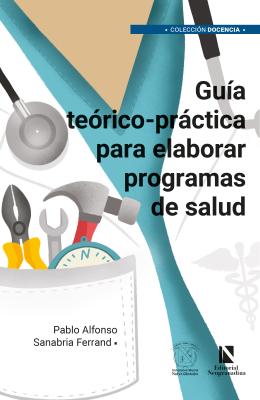Theoretical-practical guide for the elaboration of health programs
Keywords:
health planning, health plans and programs, prevention and control, health promotion, theoretical modelsSynopsis
This book is a theoretical and practical guide for healthcare professionals to learn how to design health programs with a scientific perspective that ensures success in their implementation. It is divided into four sections: The first section, titled “Before Getting Started,” introduces the concepts of health, health promotion, prevention, health education, health programs, theories, and models. It concludes with a description of the ecological model as a framework for addressing health issues and developing programs. The second section, titled “Understanding the Problem from an Individual Perspective,” explains why individuals engage in unhealthy behaviors based on behavioral theory, the health belief model, the theory of reasoned action and planned behavior, precaution adoption models, and the transtheoretical model. It ends with a guide to identifying behaviors of interest for change. The third section, titled “Understanding the Problem from an Interpersonal Perspective”, presents theories of social learning and social support, the transactional model of stress and coping, interpersonal communication theory, communication principles, and the innovative behavior change wheel and the COM-B model (Capability, Opportunity, and Motivation for Behavior). The fourth and final section, titled “Planning a Health Program,” introduces two theories to consider when designing a health program: the PRECEDE-PROCEED model and the Altadir Popular Planning Method (MAP).
Chapters
-
Capítulo 1. Antes de comenzar
-
Capítulo 2. ¿Cómo entender el problema desde la perspectiva del individuo?
-
Capítulo 3. ¿Cómo entender el problema desde la perspectiva interpersonal?
-
Capítulo 4. ¿Cómo planear un programa de salud?
Downloads
References
Ajzen, I. (1991). The Theory of Planned Behavior. Organizational Behavior and Human Decision Processes, 50, 179-211. https://doi.org/10.1016/0749-5978(91)90020-T
Bandura, A. (1977). Social learning theory. Journal of personality and social psychology. http://www.ncbi.nlm.nih.gov/sites/entrez?Db=pubmed&DbFrom=pubmed&Cmd=Link&LinkName=pubmed_pubmed&LinkReadableName=RelatedArticles&IdsFromResult=15093&ordinalpos=3&itool=EntrezSystem2.PEntrez.Pubmed.Pubmed_ResultsPanel.Pubmed_RVDocSum
Bradshaw, J. (1972). Taxonomy of social need. En G. McLachlan (Ed.), Problems and progress in medical care: essays on current research, 7th series. (pp. 71-82). Oxford University Press. http://eprints.whiterose.ac.uk/118357/1/bradshaw_taxonomy.pdf
Bronfenbrenner, U. (1976). The ecology of human development: history and perspectives. Psychology, 19, 537-449.
Bronfenbrenner, U. (1977a). Lewinian space and ecological substance. Journal of Social Issue, 33(4), 199-212. https://doi.org/10.1111/j.1540-4560.1977.tb02533.x
Bronfenbrenner, U. (1977b). Toward an experimental ecology of human development. American Psychologist, 32(7), 513-531. https://doi.org/10.1037/0003-066X.32.7.513
Bronfenbrenner, U. (1986). Ecology of the family as a context for human development: research perspectives. Developmental Psychology, 22(6), 723-742. https://doi.org/10.1037/0012-1649.22.6.723
Cane, J., O’Connor, D. y Michie, S. (2012). Validation of the theoretical framework. Implementation Science, 7, 37. https://doi.org/10.1186/1748-5908-7-37
Card, A. J. (2017). Moving Beyond the who Definition of Health: A New Perspective for an Aging World and the Emerging Era of Value-Based Care. World Medical and Health Policy, 9(1), 127-137. https://doi.org/10.1002/wmh3.221
Clayton, A., Verma, P. y Pegna, S. W. (2020). mapp Evolution Blueprint Executive Summary Executive Summary. Naccho. https://www.naccho.org/uploads/downloadable-resources/MAPP-Evolution-Blueprint-Executive-Summary-V3-FINAL.pdf
Costa, M. y López, E. (2008). Promoción de la salud y educación para la salud en el mundo en que vivimos. En M. Costa y E. López (Eds.), Educación para la salud. Guía práctica para promover estilos de vida saludables (pp. 33-59). Editorial Pirámide. https://doi.org/10.1590/S0864-34662007000200004
Davis, R., Campbell, R., Hildon, Z., Hobbs, L. y Michie, S. (2015). Theories of behaviour and behaviour change across the social and behavioural sciences: a scoping review. Health Psychology Review, 9(3), 323-344. https://doi.org/10.1080/17437199.2014.941722
Fachado, A., Menéndez, M. y González, L. (2013). Apoyo social: mecanismos y modelos de influencia sobre la enfermedad crónica. Cuadernos de Atención Primaria, 19, 118-123.
Fallon, C. K. y Karlawish, J. (2019). Is the who Definition of Health Aging Well? Frameworks for “Health” After Three Score and Ten. American Journal of Public Health, 109(8), 1104. http://doi.org/10.0.8.57/AJPH.2019.305177
Ferlander, S. (2007). The Importance of Different Forms of Social Capital for Health. Acta Sociológica, 50, 115-128. https://doi.org/10.1177/0001699307077654
Fishbein, M., Triandis, H., Kanfer, F., Becker, M., Middlestadt, S. y Eichler, A. (2001). Handbook of Health Psychology. In A. S. Baum, T. A. Revenson y J. E. Singer (Eds.), Handbook of Health Psychology (pp. 5-7). Psychology Press. https://doi.org/10.4324/9781410600073
Flórez, L., García, J. y Owen, E. (2005). Psicología y Salud. Psicología y Salud, 15(1), 135-151. https://doi.org/10.16925/2382-3984.2019.02.03
Glanz, K. y Rimer, B. K. (2012). Theory at a Glance. A Guide For Health Promotion Practice (Second Edition). National Cancer Institute. https://doi.org/10.1111/j.1360-0443.1989.tb03059.x
Goncalves, M., Montero, M. e In, M. (2003). Las redes comunitarias. En M. Montero (Ed.), Teoría y práctica de la Psicología Comunitaria. La tensión entre comunidad y sociedad (pp. 173-202). Paidós.
Green, L. W. y Kreuter, M. W. (2005). Health program planning: An educational and ecological approach (4th ed.). McGraw-Hill.
Heaney, C. e Israel, B. (2008). Social networks and social support. En K. Glanz, B. K. Rimer y K. Viswanath (Eds.), Health Behavior and Health Education. Theory, Research, and Practice (5th Edition, pp. 189-210). Jossey-Bass.
House, J. S., Umberson, D. y Landis, K. R. (1988). Structures and Processes of Social Support. Annual Review of Sociology, 14, 293-318. https://doi.org/10.1146/annurev.so.14.080188.001453
Huber, M., André Knottnerus, J., Green, L., van der Horst, H., Jadad, A. R., Kromhout, D., Leonard, B., Lorig, K., Loureiro, M. I., van der Meer, J. W., Schnabel, P., Smith, R., van Weel, C. y Smid, H. (2011). How should we define health? British Medical Journal, 343(7817), 1-3. https://doi.org/10.1136/bmj.d4163
Kurtz, S. M. (2002). Doctor-patient communication: principles and practices. Canadian Journal of Science, 29(2), 23-29. https://doi.org/10.1017/S0317167100001906
Larson, J. S. (1999). The conceptualization of health. Medical Care Research and Review: MCRR, 56(2), 123-136. https://doi.org/10.1177/107755879905600201
Last, J. M. (2007). A Dictionary of Public Health. Oxford University Press. https://doi.org/10.1093/acref/9780195160901.001.0001
Laverack, G. (2014). Health promotion in context. En The Pocket Guide To Health Promotion (pp. 3-13). McGraw-Hill Education, Open University Press. https://doi.org/10.1007/978-1-137-35049-7_29
Lazarus, R. S. (2006). Emotions and interpersonal relationships: toward a person-centered conceptualization of emotions and coping. Journal of Personality, 74, 9-46. https://doi.org/10.1111/j.1467-6494.2005.00368.x
Lazarus, R. S. y Cohen, J. B. (1977). Environmental Stress. En I. Altman y J. F. Wohlwill (Eds.), Human Behavior and Environment. Vol. 2 (pp. 89-127). Springer. https://doi.org/https://doi.org/10.1007/978-1-4684-0808-9_3
Leonardi, F. (2018). The Definition of Health: Towards New Perspectives. International Journal of Health Services, 48(4), 735-748. https://doi.org/10.1177/0020731418782653
Longest, B. B. (2014). The work of managers in health programs. En Health Program Management: From Development Through Evaluation (pp. 1-33). John Wiley & Sons, Incorporated. http://ebookcentral.proquest.com/lib/umng-ebooks/detail.action?docID=1791340
Lozares, C. (2005). Bases sociometodológicas para el análisis de redes sociales. Revista de Metodología de Ciencias Sociales, 10, 9-35. https://doi.org/10.5944/empiria.10.2005.1042
McCartney, G., Pophamb, F., McMasterc, R. y Cumbers, A. (2019). Defining health and health inequalities. Public Health, 172, 22-30. https://doi.org/10.1016/j.puhe.2019.03.023
McKenzie, J. F., Neiger, B. L. y Thackeray, R. (2013). Models for Program Planning in Health Promotion. En Planning, Implementing, & Evaluating Health Promotion Programs: A Primer (6th edition, pp. 55-57). Pearson.
Mcleroy, K. R., Bibeau, D., Steckler, A. y Glanz, K. (1988). An Ecological Perspective on Health Promotion Programs. Health Education & Behavior, 15(4), 351-377. https://doi.org/10.1177/109019818801500401
Michie, S., Atkins, L. y West, R. (2014). The Behaviour Change Wheel: A Guide to Designing Interventions. Silverback Publishing.
Michie, S., van Stralen, M. M. y West, R. (2011). The behaviour change wheel: A new method for characterising and designing behaviour change interventions. Implementation Science, 6(1), 42. https://doi.org/10.1186/1748-5908-6-42
Naccho. (2008). Improving Health Requires Partners Mobilizing for Action through Planning and Partnerships: A Community Approach to Health Improvement.
Fact Sheet oms. (1986). Carta de Ottawa para la prevención de la salud. https://www.paho.org/hq/dmdocuments/2013/Carta-de-ottawa-para-laapromocion-de-la-salud-1986-SP.pdf
oms. (2005). Carta de Bangkok para la promoción de la salud en un mundo globalizado. https://www.who.int/healthpromotion/conferences/6gchp/BCHP_es.pdf?ua=1
oms. (2008). Subsanar las desigualdades en una generación. https://doi.org/10.1017/CBO9781107415324.004
oms. (2020). Preguntas frecuentes: ¿Cómo define la oms la salud? https://www.who.int/es/about/who-we-are/frequently-asked-questions
Perea, R. (2004). El concepto de salud: su evolución histórica y cultural. En R. Perea (Ed.), Educación para la salud, reto de nuestro tiempo (pp. 100-105). Díaz de Santos.
Pineault, R. y Daveluy, C. (1987). La planificación sanitaria: conceptos, métodos, estrategias. Masson. Masson, S. A.
Prochaska, J. y di Clemente, C. (1982). Transactional therapy: toward a more integrative model of change. Psichoterapy: Theory, Research and Practice, 19, 279-282. https://doi.org/10.1037/h0088437
Rosenstock, I. M. (1988). Social learning theory and the health belief model. Health Education Quarterly, 15(2), 175-183. https://doi.org/10.1177/109019818801500203
Rotter, J. B. (1954). Social learning and clinical psychology. Prentice-Hall. https://doi.org/10.1037/10788-000
Ruiz, C. y Nucamendi, G. (2018). Evolución de la salud pública y la medicina preventiva. En R. Alvares & P. Kun (Eds.), Salud pública y medicina preventiva (pp. 1-3, 5.a ed.,). Manual Moderno.
Shilton, T., Sparks, M., McQueen, D., Lamarre, M. C. y Jackson, S. (2011). How should we define health? Proposal for new definition of health. British Medical Journal, 343(7821), 53-59. https://doi.org/10.1136/bmj.d5359
Starfield, B. (2001). Basic concepts in population health and health care. Journal of Epidemiology and Community Health, 55(7), 452-454. https://doi.org/10.1136/jech.55.7.452
Skinner, B. F. (1975). La conducta de los organismos. Fontanella.
Taylor y Francis Online. (2012). Report of the 2011 Joint Committee on Health Education and Promotion Terminology. American Journal of Health Education, 43(sup. 2), 1-19. https://doi.org/10.1080/19325037.2012.11008225
The Lancet. (2009). What is health? The ability to adapt. The Lancet, 373(9666), 781. https://doi.org/10.1016/S0140-6736(09)60456-6
The Pan American Health Organization. (2012). Declaración de Alma-Ata. Conferencia Internacional Sobre Atención Primaria de Salud, Alma-Ata, urss. 6-12 de septiembre de 1978.
Universidad de Kansas. (2021, 19 de octubre). Caja de herramientas comunitarias. https://ctb.ku.edu/es/tabla-de-contenidos/vision-general/modelos-dedesarrollo-para-la-salud-en-la-comunidad/PRECEDER-PROCEDER/principal
Weinstein, N. D. (1988). The Precaution Adoption Process. Health Psychology, 7, 355-386. https://doi.org/10.1037/0278-6133.7.4.355
Weinstein, N. D. y Sandman, P. M. (1992). A Model of the Precaution Adoption Process: Evidence from Home Radon Testing. Health Psychology, 11, 170-180. https://doi.org/10.1037/0278-6133.11.3.170
West, R., Michie, S., Atkins, L., Chadwick, P. y Lorencatto, F. (2019). Achieving behaviour change: A guide for local government and partners About Public Health England. Public Health England. https://assets.publishing.service.gov.uk/government/uploads/system/uploads/attachment_data/file/875385/PHEBI_Achieving_Behaviour_Change_Local_Government.pdf


This work is licensed under a Creative Commons Attribution-NonCommercial-NoDerivatives 4.0 International License.












